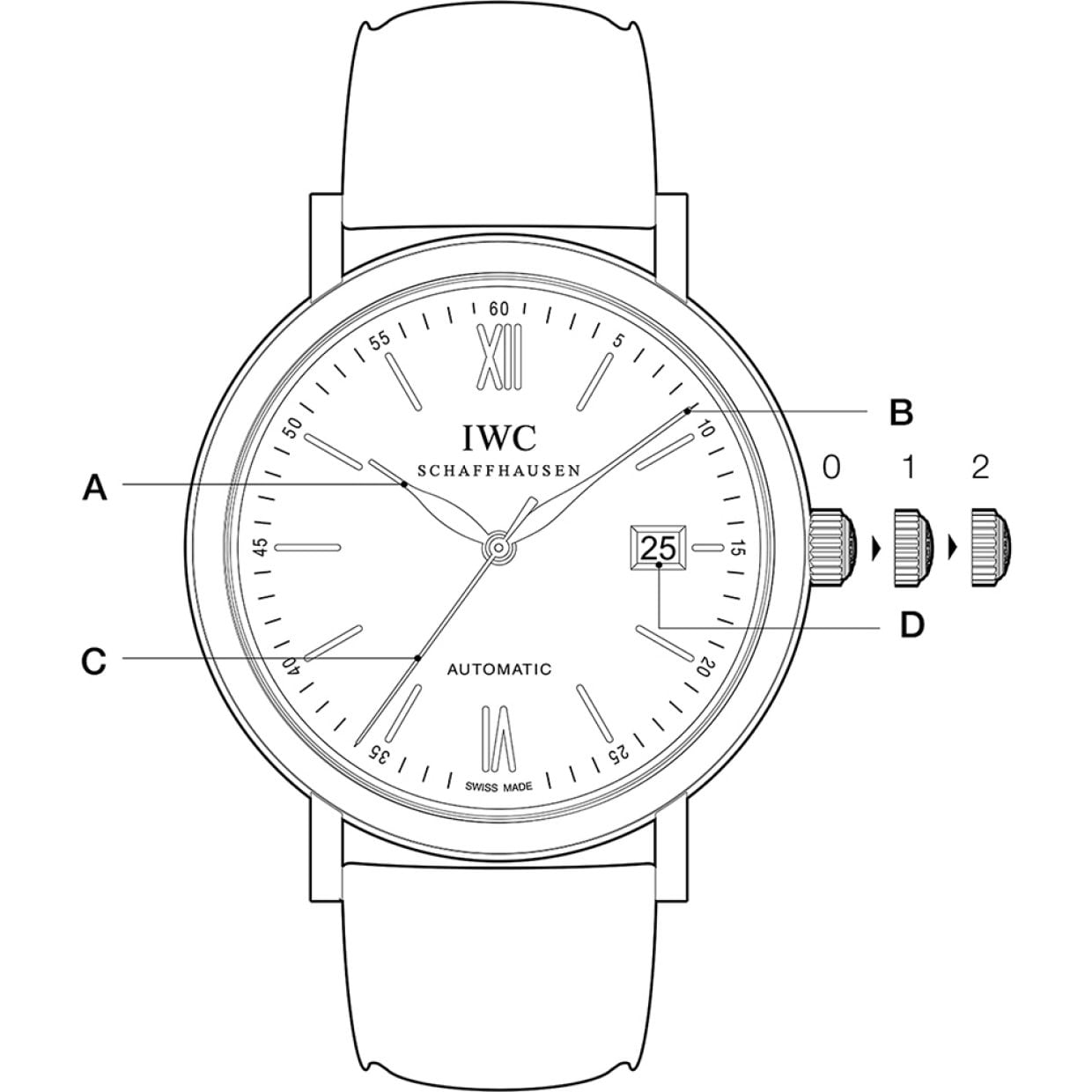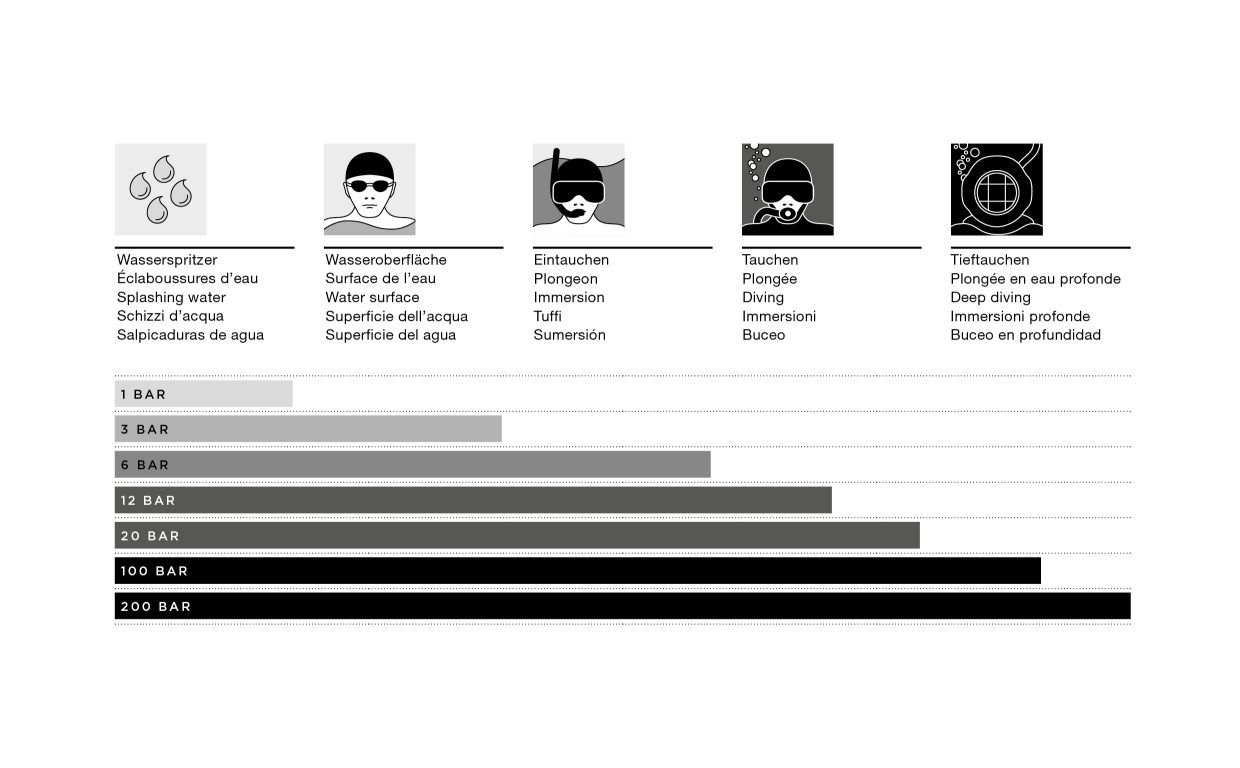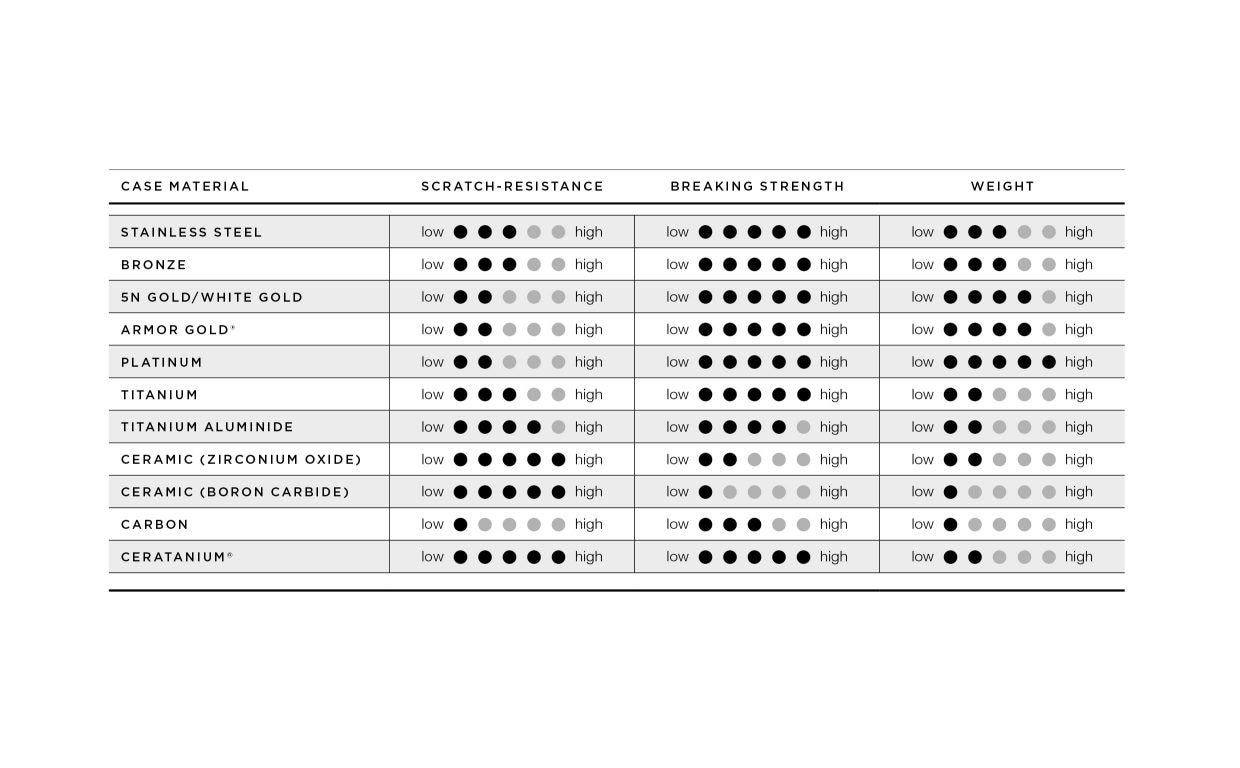IWC Schaffhausen
IWC
IWC SCHAFFHAUSEN
Instruction manual for reference: 3565

How to correctly wind your automatic watch
Functions of the crown
NORMAL POSITION
When wearing the watch, the crown should be in position 0, the winding position. The winding position is also the “off” position for the crown.
WINDING POSITION
With the crown in the winding position (position 0), you can wind the movement by hand. Around 10 to 20 revolutions of the crown in the winding direction are enough to start the movement. Once fully wound, the watch’s maximum running time will be available, ensuring the precision and maintaining the movement’s rate even after taking off the watch and up to a few hours before the power reserve is depleted.
DATE AND DAY SETTING
You should not use the rapid-advance function between 9 p.m. and 3 a.m. because the movement automatically advances the date during this period and this could damage the switching mechanism.
If a month has fewer than 31 days, you will need to set the date manually to the first day of the following month. Pull the crown out to position 1. In this position, you can advance the date by 1 day at a time using the direct advance by turning the crown slowly but continuously to the right.
How to set the date on your watch
TIME SETTING
TIME SETTING
Before pulling the crown out to its limit to set the time, you should ensure that the watch still has a few hours’ power reserve. Otherwise, the crown should be pushed into position 0, the winding position, and the watch should be wound.
For watches with a date display, there is a middle position for the crown. By pulling the crown out to its limit, position 1, used for setting the date, will be skipped and the crown will be in position 2.
If the crown is completely pulled out, the movement will be automatically stopped and the time can be set by turning the crown.
You can set the time by turning the crown and positioning the minute hand exactly above the minute stroke. When doing this, move the minute hand a few minute strokes beyond the time to be set. The minute hand can be positioned exactly above the correct minute stroke by moving it backwards gently. This ensures that the minute hand begins to move immediately when you restart the movement.
When setting the time, please check whether the date change takes place at 12 midnight. If this change has already taken place at 12 noon, you must move the hands forwards by 12 hours.
To start the seconds hand, push in the crown to position 0.
CROSSING THE INTERNATIONAL DATE LINE
Setting when crossing the International Date Line: When crossing the International Date Line in a westerly direction (you enter the next day, regardless of the time of day), simply turn the time forwards to the new local time, and the date change will take place automatically. When crossing the International Date Line in an easterly direction (you enter the previous day, regardless of the time of day), you must likewise set your watch forwards to the new local time. However, your watch will now indicate the wrong date (1 day too many). This incorrect date indication can be corrected by resetting the hands twice, by 12 hours on each occasion: Setting the watch back by 12 hours during the afternoon between 2 p.m. and 8 p.m. will prevent the calendar from advancing at midnight. Setting the watch back another 12 hours the following morning between 2 a.m. and 11 a.m. will synchronize the date display with the local date.
Setting when crossing time zones: When crossing time zones in an easterly direction, you should simply set the time forwards to the new local time. When crossing time zones in a westerly direction, you can set the hands of your watch back to the actual time of day. When doing this, however, you must not move back into the calendar’s automatic switching phase, i.e. beyond 2 a.m. If this situation occurs when you are travelling west, you should set the local time of your destination before 8 p.m. You must not turn the hands back between 8 p.m. and 2 a.m. This is because the calendar does not move backwards by 1 day when the hands are turned back beyond midnight, but remains on the same day. If you go past the end of the calendar’s switching phase (i.e. beyond 2 a.m.) when turning the hands back, you run the risk of the calendar advancing by 1 day for a second time and thus indicating 1 day too many.
How to adjust your Milanese bracelet
INFORMATION ABOUT MAGNETIC FIELDS
Extremely strong permanent magnets are increasingly found in everyday objects and are an integral part of items such as fasteners on handbags, jewellery cases and cupboards, headphones and magnetic toys. The magnetic fields produced by such permanent magnets can negatively influence the precision of mechanical watches. Mechanical watches should be kept away from such magnetic fields.
However, should there be a sudden change in the precision of your timepiece despite your having taken precautions, please contact an authorized IWC Official Agent or an IWC service centre so that your watch can be demagnetized and restored by a specialist.
WATER-RESISTANCE

The water-resistance of IWC watches is stated in bar and not in metres. Metres, which are often used elsewhere in the watch industry to indicate water-resistance, cannot be equated with the dive depth because of the test procedures that are frequently used. The following are some examples for explanation: an IWC watch with an indicated water-resistance of 1 bar is protected against splashing water. With water-resistance of 3 to 5 bar, the watch can be worn when swimming or skiing, and at 6 to 12 bar it will have no problem with water sports or snorkeling. Diver’s watches with an indicated water-resistance as of 12 bar are professional measuring instruments designed for scuba-diving. Special diver’s watches resistant to 100 bar or 200 bar are suitable even for deep-sea diving. The recommended uses for IWC watches, depending on the degree of water-resistance, are established on this basis and on the basis of empirical data, and are indicated in the inserted table here.
Remember that temperature fluctuations and external influences – due to solvents, cosmetics or dust, or caused by shocks, impacts or sudden movements – can fundamentally affect the watch’s water-resistance. Therefore, before engaging in activities that could be potentially damaging to your watch (team sports, high diving, etc.), you are advised to put it in a safe place. Please also bear in mind that not every strap or bracelet is suitable for use in or under water because of the materials used in its construction. Furthermore, with the exception of diver’s watches, the moving parts of the watch (crown, buttons, etc.) should not be operated under water. Before wearing the watch in or under water, you should also ensure that all moving parts are in the “off” position.
It should also be noted that the water-resistance of a watch is not a permanent characteristic. Seals and sealing systems in particular are subject to wear and tear and natural ageing. To care for your IWC watch, please read the operating instructions carefully. After use in or under water, your watch should be rinsed with clear, fresh and lukewarm water and then cleaned and dried. The watch’s water-resistance should be tested regularly, and at least annually, by an authorized IWC Official Agent. Further instructions for care can be found in the corresponding operating instructions.
All the Aquatimer models feature an external/internal rotating bezel that is used to set dive times. The IWC SafeDive® system ensures that the internal rotating bezel can only be adjusted when the external bezel is rotated in an anticlockwise direction. As a result, even if the external bezel is accidentally moved, zero hour – the time at which the diver can return to the surface without the need for decompression stops – cannot be exceeded. Further instructions can be found in the corresponding operating instructions.
IWC SafeDive® is a trademark of IWC Schaffhausen registered in many jurisdictions worldwide.
SERVICING YOUR WATCH
The optimal service cycle for your IWC timepiece is exclusive to your watch and unique lifestyle. The necessary interval between services will be determined by your individual wearing habits – such as the frequency of wear, the environment(s) you live in and the intensity of physical activity you engage in. Your watch is a finely tuned mechanical instrument. The more carefully you handle your watch, the longer it will continue to function flawlessly. We simply recommend that you continue wearing your watch for as long as you please and to only entrust it for a service if you notice a deviation from the regular performance, function or timekeeping. In this case, we will be happy to return your watch to its original performance level as part of servicing.
CASE MATERIALS

No result found
For manuals from past collections, please contact our concierge who can provide you with the appropriate documents.
Send us a message through our online form.























































































